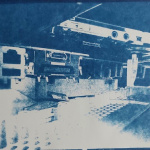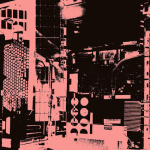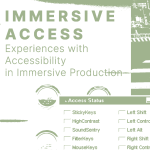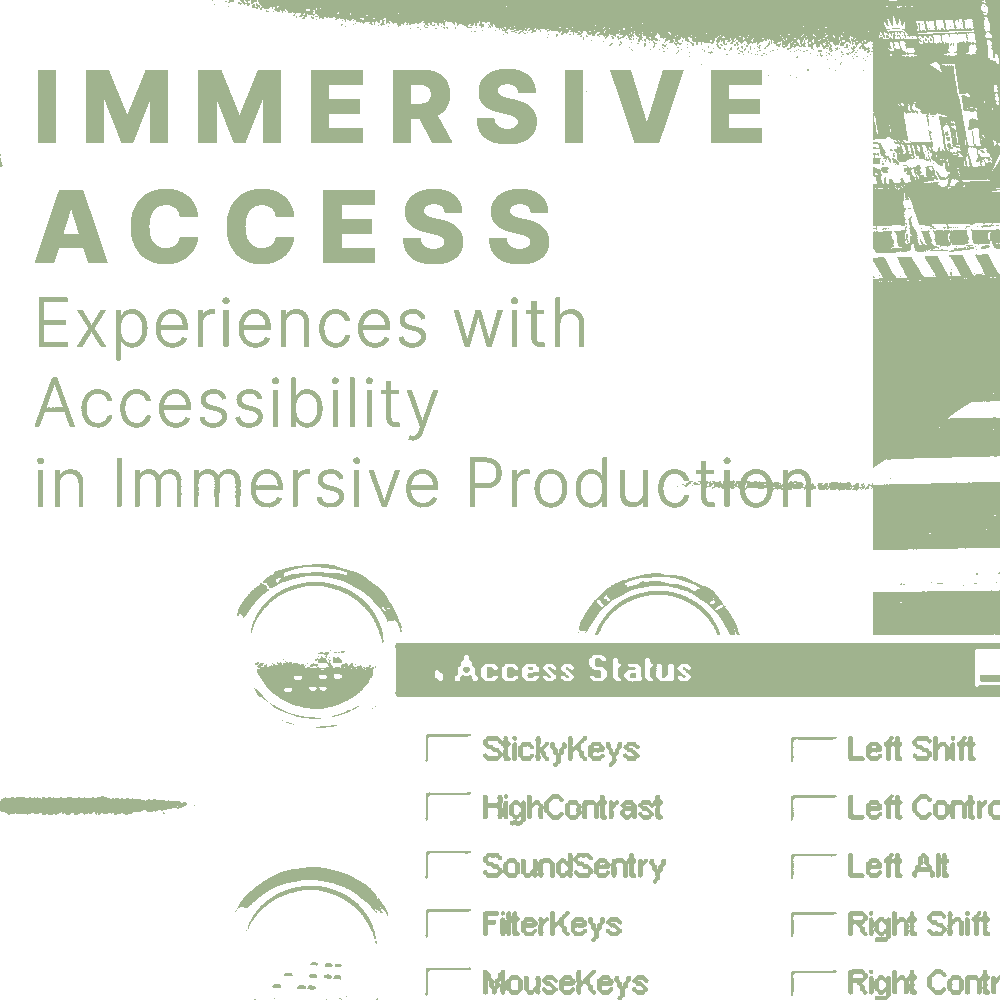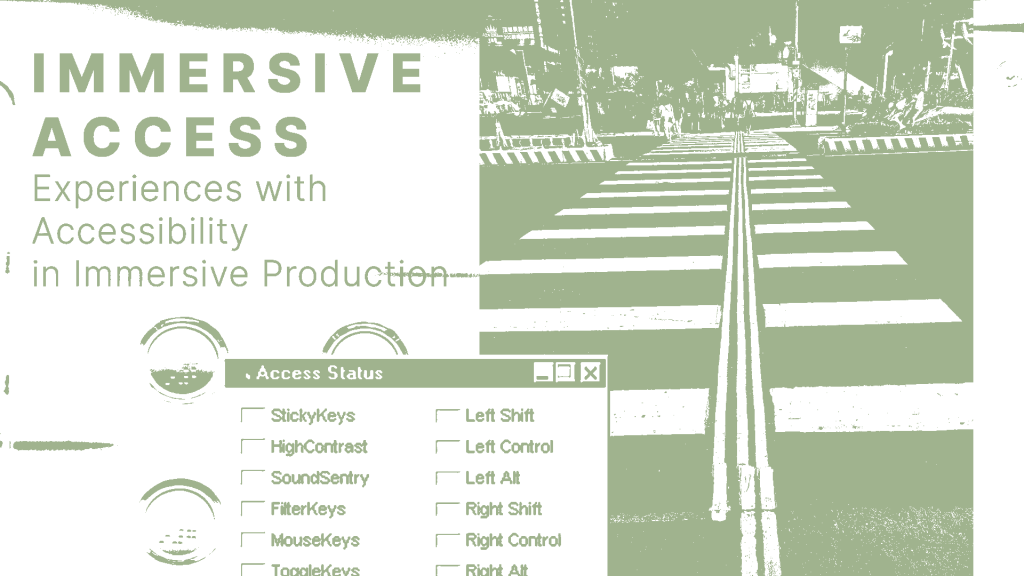I wanted to investigate how immersive technology is changing the landscape of access in media & creative production. Breaking down a huge, rapidly changing industry & taking an overview on a subject as complex as disability & access is no easy feat: I interviewed an amazing collection of accessibility champions from grass roots theatre to major film producers. I even got some chat from the Telly!
My opinion: “Accessibility is often used as a buzz word but the reality of creating access opportunity needs real investment of people & finance & it frequently & very often: doesn’t happen.”
Accessibility definition: of being reached or obtained easily. The accessibility definition culturally & in terms of work & economy means: having jobs, centres, institutions, education & economic routes open & accessible to all regardless of “disability.”
Interviews on Accessibility in Arts, Media & Immersive Technology
I’m going to open with Shape Arts’ commentary. I feel it addresses the issues that are most significant:
Shape Arts
Shape Arts are an organisation working to improve access to cultural experiences for disabled people. They model their work on the Social Model of Disability in which disabled individuals aren’t the problem but the barriers society presents to disabled people are. I got their perspective here:
“Emerging immersive technologies have the potential to break down barriers for disabled audiences by offering an expanded, multi-sensory ‘experience’ of culture in place of more traditional modes of engagement like ‘seeing’ art or ‘listening’ to sonic work, providing new and innovative pathways into an artist’s project.
It also has the capacity to bridge the gap between in-place and online delivery by generating shared experiences and encounters between the two, helping to connect with audiences with different needs and preferences and affording greater flexibility to the artist as well.
However, though the potential for greater accessibility is there, it will only succeed if these technologies are used thoughtfully and not taken for granted. The audience’s journey from encounter through to experience must still be considered from an access perspective, and this may not always be enhanced with the latest technology. Effective access provision cannot be one-size-fits-all. If we rush into relying upon emerging technologies to do the work of making culture accessible, we run the risk of overlooking the fact that there is, today, still much work to be done to remove barriers that stem from attitudinal and structural inequities which technology cannot resolve alone.”
Shape Arts highlight digital exclusion & barriers to education:
“Digital exclusion and barriers to education may mean that these new experiences, those which utilise immersive technology to enhance cultural offerings, still only connect with audiences who are already culturally engaged and included. Those already excluded or isolated will, in effect, move down another rung in the cultural ladder if we make assumptions about the benefits of technology without sensitivity to pre-existing barriers to access.
For example, many new technologies being used within cultural settings take for granted that people have smartphones or the latest upgrades which afford them access to the work on display, to say nothing of the fact that these necessary intermediary devices may themselves present barriers to access for many.”
Channel 4
In the years I’ve worked in media I’ve seen many changes & recently there is more focus on diversity & inclusion. I got Nicole Steven, Disability & Creative Diversity Manager from Channel 4 to give us an overview of how the media environment has been for those trying to access work:
How has the employment landscape been changing for disabled media employees at Channel 4 in the last 5 years?
“Following the release of the Underlying Health Condition report and Jack Thorne’s McTaggart speech, it has become evident that there is a pressing need for change in the industry. The TV Access Project has made significant strides, with broadcasters and streamers committing to achieving full inclusion for disabled talent by 2030. However, there are still many challenges to address before this can become a reality. Each of the broadcasters and streamers participating in the TV Access Project are involved in workstreams that focus on progress and shaping future initiatives. Promising changes and developments have emerged from these workstreams already which will soon become industry standards. As an industry, with the help of disability advocates and the work of TAP, and commitments from the industry, we are witnessing significant changes, but there is still a long way to go.”
How could things be better for disabled individuals wanting to work in T.V in the wider industry?
“Accessibility is key for disabled talent to work equitably and progress in our industry. We have various initiatives for our Channel 4 shows that help us establish more accessible spaces for our talent. We provide guidance to productions on creating accessible production spaces, securing funding for reasonable adjustments, and offering advice on hiring, including and advancing disabled talent. These initiatives are in place to ensure that our disabled talent feel reassured and confident when working on our productions.”
Do you have any ideas on how new immersive technology might make media careers accessible?
“I will be honest I’m not so knowledgeable when it comes to tech! I’m sure however over the next few years we will see so much change when it comes to how tech can create greater accessibility in our industry. As with almost everything disabled people need to be included in the conversation. With the famous saying “Nothing about us without us” we need to see disabled voices in senior positions when this technology is being created so we can get that other point of view. Without that lived experience we won’t ever see those great leaps in accessibility within our industry.”
Distortion Studios:
I wanted to look at film studios & networks & give some personal insight. For those starting off in media careers or making a career pivot something being offered is bursaries to conventions & conferences.
I was lucky enough to get a Creative Cities Convention ticket through the MyWorld Springboard Fund – the event put thought into accessibility – it was in a fully accessible building, the organisers were willing to provide extra access support, there was a quiet room & good staff sign posting & signage.
At the event I learned about Distortion Studios, a new Bristol based immersive studio at the forefront of modern media and creative production tech. Working with productions from L.A to Singapore they can produce work that isn’t reliant on travel to locations, down to a GINORMOUS L.E.D setup, which is a great consideration for making productions both more accessible & sustainable. They are making accessibility a focus, which IS cutting edge, but in my humble opinion: something ALL companies & organisations should be doing.
I was invited to Distortion Studios’ launch. At the event I met Jonathan Bridgen, whose studios’ projects have won multiple awards, & we chatted about access. He says:
“I run Distortion Studios and a studio called Studio Giggle. Both organisations are in essence in the creative industry, one’s a virtual production specialist film studio, and one’s a content driven event company.
The creative industries are famously inaccessible, in many many ways, cultural, ethnic, socio-economic background, and through disability as well. And I think, especially in the creative industry, a lot of neurodiversity is quite common, so, we have a very neurodiverse team, and so that’s the main kind of engagement we have with disability. We’ve been building this new studio, and been trying to make it as accessible as possible, and so far been very successful. For instance, with this building it did transpire that, because of the way it’s built, we ended up with a pinch point, and so had to remove a door, because as the door opened, literally that amount of space meant that a chair couldn’t get through.”
Jonathan put me in touch with practitioners he’d worked with on a project for more detail on how the process works.
Rhys Miles Thomas & Paul Burke
Rhys Miles Thomas is an accessibility expert & pioneer working with producer Paul Burke & they have been shooting a highly ambitious film for disabled crew & actors. They also produced a report on disability in the film industry for Wales.
Rhys described the film, which you can watch test footage for here, as “A sci-fi mix, people have been exiled to far away planets and they have to come back, find their way back to Earth, but when they do they come back as children and they live their lives again. So in the excerpt you’ve seen parts of, the main character is a prisoner on a far-away planet, and he’s trying to find a way to come back.”
“We had some money for a report last year on how accessibility can be improved for DDN (Deaf, Disabled, Neurodivergent) people through virtual production, which is where everything is in the studio and on LED screen, and so people wouldn’t have to travel, go abroad, they can do it in their locale and still take an active important part in things, not just at the level of a runner or a junior, but as well as heads of department.”
“The impetus for it started about twenty years ago, I was an actor working in American television, and we did a production of Jason and the Argonauts, out in Turkey, and one of the days we were filming was on top of a mountain which could only be accessed by helicopter. At the time I was able bodied and so I could do it, now I’m in a wheelchair and there’s no chance on Earth that I’d ever be able to. So I was selfishly thinking, nowadays, was there a way now based on technology today, I’d be able to do a production like that without having the hindrance of the barriers of an able bodied world.”
“Paul is a big VFX producer, and he had been working remotely a lot, because of covid, and he was saying “have you looked at things like virtual production” and I never had and so we both teamed up, did this report and found that – yes, if we can prove that actually we can produce the same quality of content without the barriers, but also without going “ah well bless them, we’ll give them a half cut thing just because they’re disabled” that sort of pity, which we all find at some point. We want to be able to compete at the highest level, with the standard at the highest level.
So, we worked on a test shoot in July with one studio, and we’re going on to do a piece for a different production, but with multiple locations across the UK, multiple studios, since despite us doing everything to help and make it accessible, it still meant people had to travel.”
“We know the technology works, but now can we make it as accessible as we possibly can, and we found well – if we have studios in the locale of people, then they’ve got all their amenities. Home comforts are important, if I have to go to a hotel it’s a nightmare because everything has to be exactly set up, but, inevitably it never is. Working hard on a day, you want that home comfort, you want that security around you, and so can we offer that? That’s what we’re trying to do.”
Liz Counsell
Grass roots, community & smaller scale productions are vital to a healthy cultural infrastructure. I interviewed Liz Counsell who is executive producer at Dan Daw creative projects and familiar with independent theatre & disability. She produces as a freelancer/consults and has personal experience of disability with a condition effecting energy & pain & is neurodivergent.
I asked how immersive technology could break some barriers to accessibility:
“It would be amazing if we could use VR in our pre show access sessions, what we normally do is take someone into the theatre and show them the brightest lights and the loudest sound before the show – but with VR we could do this anywhere – they could make an informed decision on whether the show was accessible to them without actually coming into the space.”
I also asked her about the challenges of using immersive technologies such as VR or L.E.D immersive screens to create access to her productions:
“Cost! We are currently exploring immersive tech (spatial sound) in our new show but what we want to do hasn’t been done before (to the best of our knowledge) and its proving inhibitively expensive.”
Lawottim Anywar
I caught up with Lawottim Anywar at Pervasive Media Studio, a hub for creatives with a remit to support neurodivergent & disabled practitioners & got these sound bites on his role and the studio & residents:
“I manage the administrative environment of the studio, and connect the studio to the wider building team at the Watershed, and manage a lot of scheduling and calendars across the team as well, but, every day is different, a lot of physical stuff, physical support for residents and admin support as well.
We try and provide a space whereby the right questions are asked and so things become more accessible across the industries. So as an example, things like applying for funding can be difficult for people with certain cognitions, certain diverse needs, so trying to connect them to people to give them the right support for that.”
One of the things that is part of the residency here is you provide some desk space and a place to work, and my experience as someone who has some access needs, is the socio-economics of the industry, where being able to access private desk space is a barrier, so in that way you’ve got a network and a shared work space.
Have you seen any new or emerging technology or do you have any ideas on how tech today can help people?
“I think one of the main things is community isn’t it, you have such a range of tools that connect you to other people, be that social media, or things where you have niche communities like Reddit or Discord, and a lot of communities have a specific focus, be that immersive arts or TV or gaming, and usually that is a way of helping people engage more with that kind of stuff. So, if you can’t easily leave your house, you may be able to get access to like-minded people through that.”
I guess one of the things that I think as a resident that the studio does well is the hub of expertise. You do see that in the studio there’s such a vibrant and diverse network of people that you have here, that really are from all kinds of walks of life, there’s this real cross-pollination, which provides a realistic look at the industry and who can and can’t access it.
My Perspective
I’ve loved writing this article. I got into this subject due to challenges in my career pathway, and amazing things have grown out of these connections.
Working in TV, media, arts & education since I began my career; recently I’ve begun a pivot into immersive arts. I saw VR’s huge potential & wishing to learn about cross sector immersive, I applied for an opportunity at Pervasive Media studios at the Watershed with MyWorld. I got to experience some new VR experiences prerelease & to take a look at the limitations of the medium in a group of artists & researchers all with access needs.
Realising I loved it, I began to look for funding & paid opportunities that might meet my needs for a job or to enhance my freelance portfolio. For me finding an adaptable, accessible employer who can offer a sustainable career package has been VERY difficult – employment & cultural engagement statistics back this as a common experience of career & cultural exclusion – disabled people often make up a low proportion of those in employment & also audiences; despite 20% of working age adults having a disability. This rises to 40% plus at retirement age.
The shocker: Did you know disclosing you have disability as you apply for a job reduces your chance of even getting a call back by 50%… why?
Disabled people are equal in talent & ability & are often unique & innovative bringing fresh perspectives. I prefer differently abled as a descriptor rather than disabled. There is plenty of ability but access & adjustments & training & kit to even have experience are needed (exclusion starts early!).
As Shape Arts mention most disability exclusion is systemic – it’s in the systems & hidden barriers & unfortunately sometimes prejudice or deliberate discrimination – but mostly I find it’s in the systems, the forever Catch 22’s, the paperwork & misunderstanding from organisations & employers.
I turned towards arts funding as a necessity – I want to be engaged & do something long term as a career that I like, where quality of life feels good & is adaptable for health challenges. I am highly qualified with broad & specialist experience. What I’ve found is that it’s hard to break in & that while there are many conversations about access, the reality rarely meets up & disabled people are only allowed a peek in before the door shuts in our faces again.
Which brings us back to Shape Arts & their summary of the barriers being structural & social & that people are disabled by society – I think access is very poorly understood & it’s only those working against the odds & trying really hard & budgeting for it that are changing things for the better.
I’ve had the same conversations about access for over 10 years & finally some companies are beginning to do the very basics eg. Adapting interviews & formats with flex for deadlines for those living with extra health challenges & creating some adaptive work/ tech environments.
It took me 6 months to get some research funding & that stipulated I couldn’t salary myself. I took it as a study opportunity whilst I pivot & grow. I struggled to find a paid opportunity to continue working in this area & finding out about opportunities has been hard with most grants processes inaccessible to me, ridiculously competitive, requiring long arduous unpaid hours. The inaccessible application processes contributed to a media industry favourite: burn out! I’ve lobbied to change these access points & had success.
Part of what I do in media & immersive is music composition & installation. I’ve liaised with several key music organisations & have contributed to improved grant application processes at: Help Musicians, PRS foundation, Sound & Music & Producer Gathering.
It is always worth speaking up & advocating.
The mentoring opportunity through MyWorld from my research award helped me gain confidence for a start-up – but funding to start up in the wider industry is hard to find & if you are from the socio-economic disadvantaged demographic it’s about 1 million times tougher, as everyone wants you to have a shiny website & prototypes & kit to even get a grant or match funding.
Catch 22: You need some investment to create these things. Money loves money & if you don’t have any most start up grants aren’t accessible to you.
Please don’t shut us out. Please don’t give us hours of unpaid labour with lengthy inaccessible processes. Please give us some deadline flex when we have met a disability related challenge.
Many disabled practitioners find themselves in insecure or unsustainable work. We need an ecosystem that includes us & stays with us – secure working conditions & career satisfaction as well as cultural experiences such as theatre, museums, T.V & immersive that includes & welcomes us (all of us!). Complex yes – but I believe in the industry & creators, we are all in the conversation.
Can immersive technology create accessibility opportunity and a more inclusive work & cultural landscape?
Yes, if it’s combined with totally reimagining & restructuring the cultural & social systems too. What I find exciting is the reimagining and the collection of trail blazers & innovators doing it.


